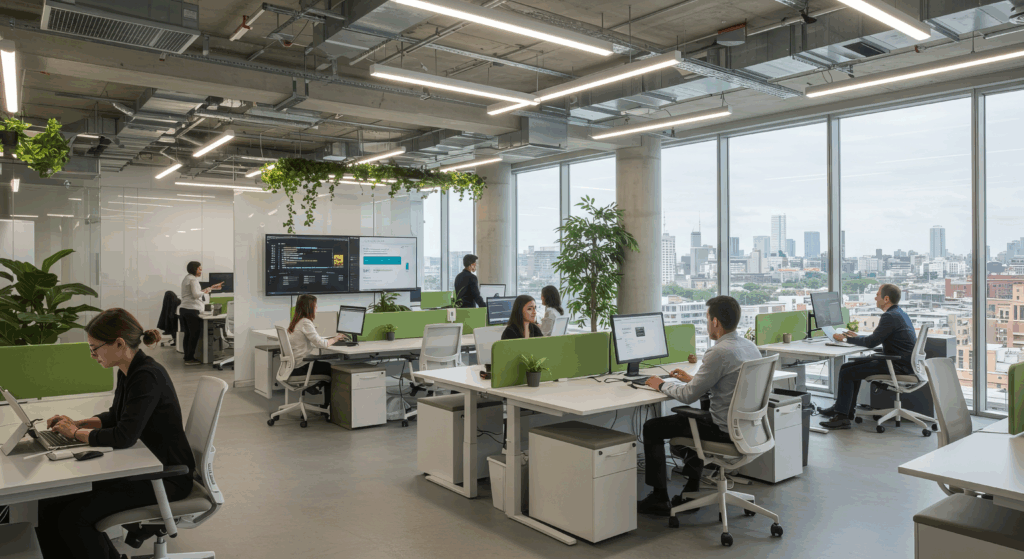
Workspaces communicate constantly with their occupants, but most professionals remain oblivious to these subtle conversations. Every corner of an office environment sends signals that either amplify productivity or quietly sabotage it. While organizations obsess over the latest productivity applications, time-management techniques, and workflow optimization tools, they consistently overlook one of the most powerful influences on performance: the strategic design and utilization of office zones.
The concept of office zones extends far beyond simply having a desk for computer work and a meeting room for discussions. It represents a sophisticated understanding of how different physical environments can prime brains for specific types of cognitive work, emotional states, and collaborative dynamics.
The Psychology Behind Spatial Productivity
Human brains demonstrate remarkable aptitude for forming associations between physical environments and mental states. Just as the sight of a bed triggers thoughts of sleep and relaxation, specific office zones can automatically shift cognitive gears toward particular types of work. This phenomenon, known as environmental psychology, reveals that surroundings don’t merely house activities—they actively participate in shaping mental processes.
When individuals consistently perform deep analytical work in a specific location, their brains begin to associate that space with focused concentration. The visual cues, lighting conditions, furniture arrangement, and even the ambient sounds of that zone become triggers that help people slip more easily into states of sustained attention. Conversely, when individuals attempt to do focused work in spaces designed for collaboration or casual interaction, they fight against these environmental cues, making concentration significantly more challenging.
Cognitive psychology demonstrates that mental resources are finite, and people can either spend them battling their environment or channel them toward productive work. Office zones essentially serve as external scaffolding for internal cognitive processes, reducing the mental effort required to shift between different types of tasks and thinking patterns.
Deep Work Sanctuaries
Creating an effective deep work zone requires understanding the delicate balance between isolation and accessibility. It should feel separate from the general flow of office activity without being so removed that it becomes impractical to use regularly.
The most successful deep work zones share several key characteristics that support sustained concentration and complex problem-solving.
Lighting plays a crucial role in these spaces, with natural light being the gold standard for maintaining alertness and reducing eye strain during extended work sessions. The ability to control lighting levels becomes equally important, as different types of analytical work may benefit from varying illumination conditions. Warmer, dimmer lighting can sometimes enhance creative thinking, while brighter, cooler light supports detailed analytical tasks.
The acoustic environment of a deep work zone deserves careful consideration as well. While complete silence might seem ideal, many people actually perform better with consistent, low-level background noise that masks intermittent distractions. This might include white noise, nature sounds, or the gentle hum of HVAC systems. The key principle is predictability—sudden noises are far more disruptive to concentration than consistent ambient sound.
Meanwhile, furniture and equipment in deep work zones should prioritize comfort and functionality over aesthetics. An uncomfortable chair or poorly positioned monitor can break concentration every few minutes, creating a constant stream of micro-interruptions that prevent deep engagement with complex tasks. These spaces should also minimize visual distractions while providing easy access to frequently needed resources and tools.
Of course, even the most thoughtfully designed deep work zones will fail to achieve their purpose without proper maintenance and cleanliness. Dust, clutter, and poor air quality can significantly impact cognitive performance and create subtle but persistent distractions that undermine concentration. This makes partnering with professional office cleaning Dallas companies trust, or similar services in your area, essential for maintaining the pristine environment that deep work truly requires.
Collaboration Spaces
Collaboration zones serve an entirely different psychological and practical purpose. These spaces need to encourage openness, spontaneous interaction, and the free flow of ideas between team members. The design principles that create effective collaboration zones often run counter to those that support individual productivity, highlighting the importance of having distinct areas for different types of work.
These areas typically feature flexible furniture arrangements that can be quickly reconfigured for different group sizes and meeting styles. Round tables often work better than rectangular ones for encouraging equal participation, while moveable whiteboards and wall-mounted displays support visual thinking and idea development. These spaces should feel inviting and energizing, with brighter lighting and more vibrant colors than deep work areas.
The acoustic properties of collaboration zones require a different approach than individual workspaces. They need to contain sound well enough to prevent disruption to nearby quiet zones while allowing for animated discussion and occasional excitement. Soft furnishings, acoustic panels, and strategic placement relative to other office zones all contribute to achieving this balance.
Technology integration becomes particularly important in collaboration zones as they often serve as the intersection point between individual preparation and group decision-making. Easy access to projection capabilities, video conferencing equipment, and shared digital tools can dramatically improve the effectiveness of collaborative sessions.

Recovery Zones
Perhaps the most overlooked category of office zones is dedicated space for mental restoration and informal interaction. These areas serve as crucial pressure valves in high-intensity work environments, providing opportunities for the kind of mental rest that actually enhances subsequent productivity rather than detracting from it.
Effective restoration zones create a clear psychological separation from work-focused areas through different furniture styles, lighting conditions, and overall ambiance. Comfortable seating arrangements that encourage relaxation, access to natural views or plants, and softer acoustic environments all contribute to the restorative quality of these spaces. The goal is to create an environment where minds can genuinely disengage from work-related stress and pressure.
The social dynamics of restoration zones require careful consideration. These spaces should facilitate casual interaction and relationship-building among team members while also providing options for solitary restoration. Some people recharge through social connection, while others need quiet individual time to restore their mental energy. The most effective restoration zones accommodate both preferences through varied seating arrangements and acoustic zones.
Making Office Zones Work in Reality
Translating the concept of office zones into practical reality requires a strategic approach that considers both the physical constraints of existing spaces and the cultural dynamics of organizations. The most successful implementations begin with careful observation of current work patterns and honest assessment of how existing spaces either support or hinder different types of productivity.
Many organizations make the mistake of assuming that office zones require extensive renovation or significant financial investment. While purpose-built spaces certainly have advantages, creative use of existing areas, strategic furniture placement, and thoughtful use of visual and acoustic cues can create effective zones within almost any office layout. The key principle is consistency—once zones are established, they need to be respected and maintained by all team members to preserve their psychological effectiveness.
Change management becomes a crucial component of successful zone implementation. People develop strong habits around how they use office spaces, and shifting these patterns requires clear communication about the purpose and benefits of different zones. Training sessions, visual cues, and gentle enforcement of zone-specific behaviors all contribute to successful adoption.
Most importantly, regular evaluation and adjustment of office zones ensures they continue to meet the evolving needs of organizations. What works well for one team composition or type of project may need modification as circumstances change. The most effective office zone strategies remain flexible and responsive to feedback from actual users.
Final Thoughts
Office zones are already influencing productivity in every workplace, whether organizations have designed them intentionally or allowed them to emerge by default. The question isn’t whether physical environments affect performance—it’s whether leaders will take control of that influence or continue to let it operate in the shadows. The silent productivity partner has been waiting patiently for attention. Perhaps it’s time for organizations to start listening.








